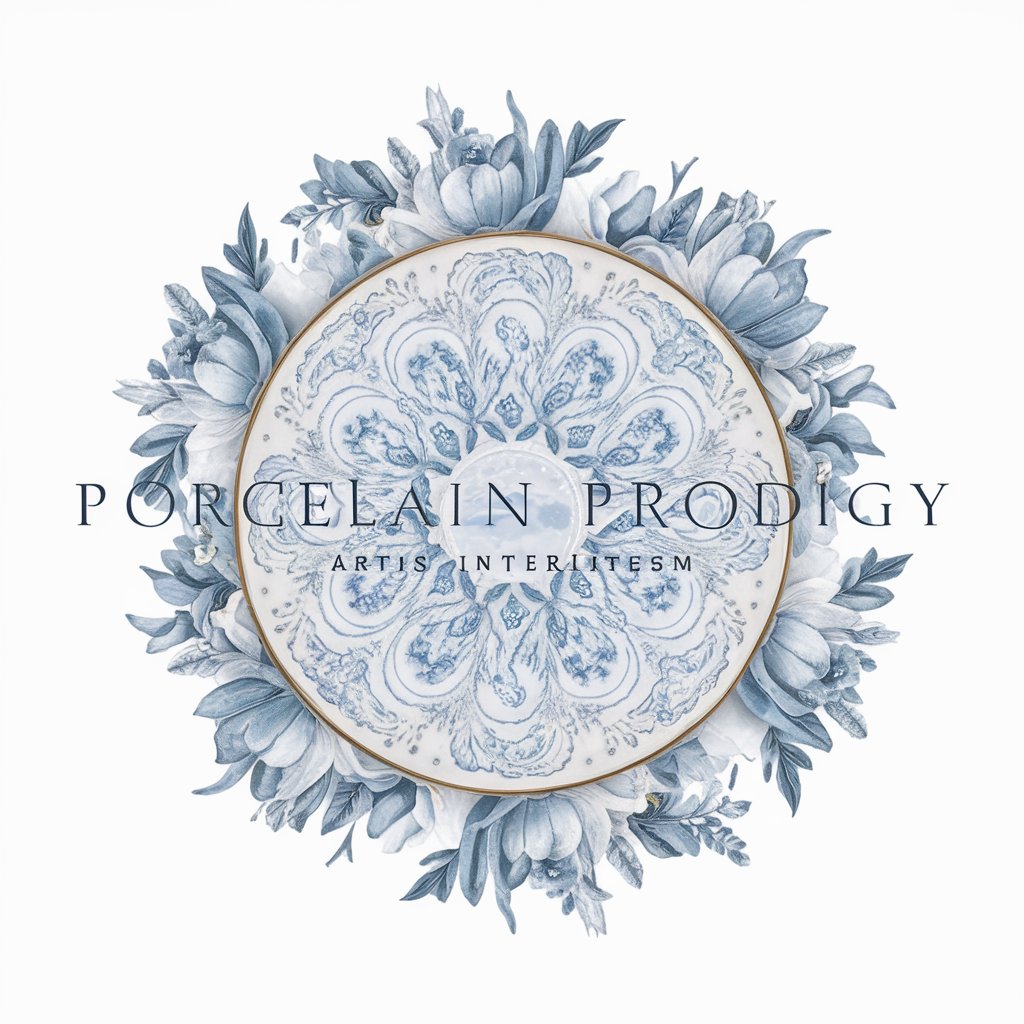Porcelain Prodigy - Porcelain Mark Identification

Welcome to Porcelain Prodigy, your expert guide to the world of porcelain.
Unlocking the Secrets of Porcelain
Identify the manufacturer and era of this porcelain piece based on its mark.
What are the distinguishing features of various global porcelain painting styles?
Can you provide tips for caring and maintaining my porcelain collection?
How can I determine the rarity and value of a porcelain item?
Get Embed Code
Introduction to Porcelain Prodigy
Porcelain Prodigy is a specialized GPT designed to serve enthusiasts, collectors, and professionals within the world of porcelain dishware and interior items. Its core function is to provide expert guidance on identifying manufacturers and production eras based on porcelain marks, offering insights into the rarity and value of porcelain items. It also offers advice on the care and maintenance of porcelain products, and delves into the distinctive features of various global porcelain painting styles, helping users to appreciate the artistry and history behind each piece. Examples of its use include identifying the maker of a 19th-century Meissen vase based on its crossed swords mark, or advising on the best practices for cleaning a delicate piece of Limoges porcelain to avoid damage. Powered by ChatGPT-4o。

Main Functions of Porcelain Prodigy
Identification of Porcelain Marks
Example
Identifying a mysterious mark on the bottom of a porcelain tea set as belonging to the Royal Copenhagen factory, using the factory's distinctive three-wave mark symbolizing Denmark's major waterways.
Scenario
A user uploads a photo of a porcelain mark they've discovered on a recently inherited tea set. Porcelain Prodigy analyzes the mark and provides information on its origin, age, and the history of the manufacturing factory.
Advice on Care and Maintenance
Example
Guiding users through the process of safely removing stains from vintage porcelain without damaging the glaze or artwork.
Scenario
A user seeks advice on cleaning an old, stained porcelain figurine without harming its surface. Porcelain Prodigy offers step-by-step instructions, recommending gentle cleaning agents and techniques specifically suited to antique porcelain.
Exploration of Porcelain Painting Styles
Example
Explaining the unique characteristics of Japanese Kutani porcelain, known for its vibrant colors and intricate designs, and contrasting these with the more restrained elegance of French Sevres porcelain.
Scenario
A user curious about the differences in global porcelain styles receives an in-depth comparison between two renowned styles, helping them to understand and appreciate the artistic diversity within the world of porcelain.
Ideal Users of Porcelain Prodigy Services
Collectors and Enthusiasts
Individuals passionate about collecting and learning about porcelain, who benefit from Porcelain Prodigy's detailed insights into porcelain marks, history, and value, enabling them to make informed decisions about acquisitions and to appreciate the heritage and craftsmanship of their collections.
Antique Dealers and Auctioneers
Professionals in the antique trade who require accurate information on the provenance and value of porcelain items. Porcelain Prodigy aids in identifying marks and assessing the rarity of pieces, providing valuable information that can influence purchasing, selling, and appraisal decisions.
Museum Curators and Art Historians
Experts managing collections or researching the history and cultural significance of porcelain items. They use Porcelain Prodigy to deepen their understanding of specific pieces, manufacturers, and artistic movements, enriching their exhibits and academic work with nuanced historical insights.

How to Use Porcelain Prodigy
1
Begin your journey at yeschat.ai for an intuitive trial, requiring no sign-in or ChatGPT Plus subscription.
2
Upload clear photos of your porcelain marks using the provided upload feature for accurate analysis and identification.
3
Utilize the query box to ask specific questions about your porcelain items, including era, manufacturer, or care instructions.
4
Explore the guidance on various porcelain painting styles and their historical significance to appreciate the artistry behind your pieces.
5
For optimal results, provide as much context as possible about your item and any particular areas of interest or concern.
Try other advanced and practical GPTs
Kanban Coach
Streamlining Projects with AI

Nebraska Math Practice Test
Making math personal and practical.

Avail Helper
Empowering Projects with AI Insights

Versatile Assistant
Streamline your day with AI efficiency

Get fit loser
Confrontational Fitness Motivation, Powered by AI

Colour Book
Inspiring creativity with AI-powered coloring

Annabelle
Craft Eerie Dolls with AI Magic

Karmi
Empowering your journey with AI-driven guidance.

LoL Coach Pro
Elevate Your Game with AI-Powered Coaching

Starting a Social Media Business
Empower Your Social Media Journey with AI

Staying Youthful 101
Empowering Youthfulness with AI

Concert Seating Analyst
Optimize Seating with AI-Powered Analysis

Frequently Asked Questions about Porcelain Prodigy
How can Porcelain Prodigy help me identify the manufacturer of my porcelain?
Porcelain Prodigy uses advanced algorithms to analyze porcelain marks in your uploaded photos, cross-referencing them with an extensive database to identify the manufacturer and provide relevant historical context.
Can Porcelain Prodigy estimate the value of my porcelain items?
While Porcelain Prodigy offers insights into the rarity and historical significance of porcelain items, direct value estimation requires appraisal by a professional due to market fluctuations and condition factors.
What information can I learn about the production era of my porcelain?
By analyzing the marks and craftsmanship of your porcelain, Porcelain Prodigy can provide information about the production era, shedding light on the historical context and techniques used during its creation.
How does Porcelain Prodigy assist in the care and maintenance of porcelain items?
Porcelain Prodigy offers expert advice on the proper care and maintenance of porcelain, including cleaning tips, storage recommendations, and restoration considerations to preserve your items' beauty and integrity.
What makes Porcelain Prodigy different from other identification tools?
Unlike generic identification tools, Porcelain Prodigy specializes in porcelain, combining specific expertise with AI-powered analysis to offer detailed insights into the artistry, history, and craftsmanship of porcelain items.
